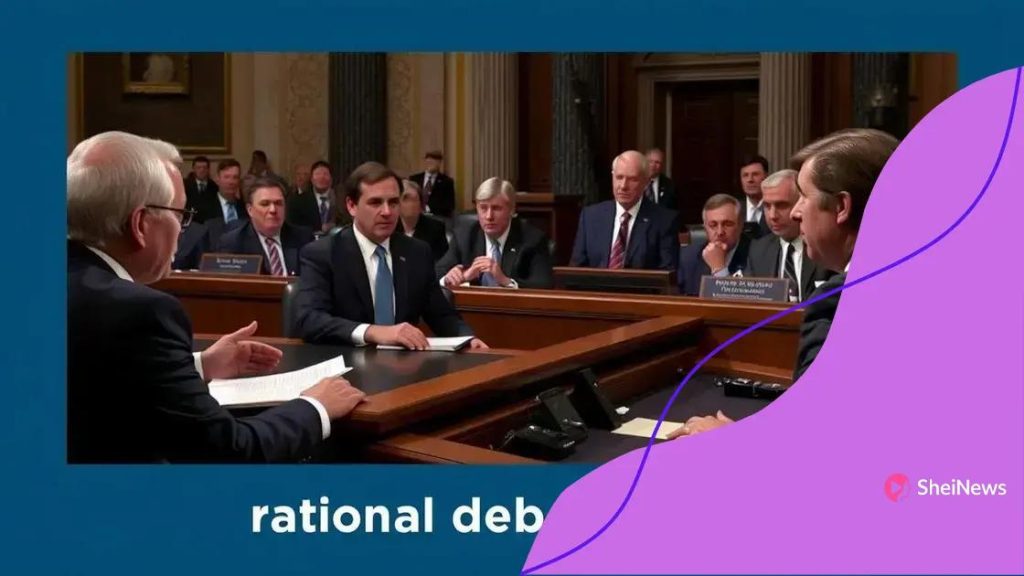National debt ceiling debates: what you need to know

Anúncios
The national debt ceiling is a limit set by Congress on the amount of money the federal government can borrow, and failing to raise it may lead to serious economic consequences including default and increased borrowing costs.
National debt ceiling debates often fly under the radar, yet they play a crucial role in shaping our economy. You might wonder how these discussions affect your life, and that’s what we’re diving into today.
Anúncios
Understanding the national debt ceiling
The national debt ceiling is a limit set by Congress on the amount of money the federal government may borrow to pay its bills. Understanding this concept is vital because it directly affects the economy and our daily lives. When the ceiling is reached, the government cannot borrow any more money unless Congress raises it.
To delve deeper, we must explore the implications that come with the debt ceiling. It often sparks intense debates among lawmakers, as they must balance the need for spending with fiscal responsibility.
How the Debt Ceiling Works
The process of raising or suspending the debt ceiling can be complex. When the government hits the ceiling:
Anúncios
- It cannot issue new debt to cover ongoing expenses.
- Federal agencies may face budget cuts.
- Payments for government benefits could be delayed.
This can create significant uncertainty in markets, affecting everything from interest rates to investor confidence.
Historical Context
Historically, the national debt ceiling has been raised many times. Each instance reveals the ongoing struggle between spending needs and the desire to maintain fiscal health. The debates surrounding these decisions can impact public perception and policy.
For example, during previous debt ceiling fights, discussions often centered around the implications of raising the limit. Lawmakers argue about prioritizing funding for essential services versus reducing the deficit. This leads to vital questions: Should the government continue to borrow, or should it cut spending in other areas?
- Political disagreements often arise during these discussions.
- Negotiations might result in short-term solutions but fail to address long-term challenges.
- Understanding these historical patterns can offer insights into future debates.
By grasping the nuances of the national debt ceiling, we can better understand the economic landscape and how it affects our financial well-being.
Historical perspectives on debt ceiling debates
Examining the historical perspectives on debt ceiling debates helps us understand how past events shape current discussions. Over the years, the debt ceiling has been raised numerous times, revealing patterns in policymaking and political strategies.
For instance, during significant economic crises, lawmakers often faced pressure to increase borrowing limits to avoid default and maintain government functions. These moments often highlight the tension between urgent financial needs and long-term fiscal responsibility.
Key Historical Events
Several critical events stand out in the history of the debt ceiling:
- The establishment of the debt ceiling in 1917 changed how Congress controlled government borrowing.
- In 1979, technical issues caused a temporary default, raising concerns about the government’s ability to manage its debt.
- The 2011 debt ceiling crisis led to a downgrade of the U.S. credit rating, impacting global markets.
These events demonstrate the potential consequences of political stalemates and highlight the urgency of finding solutions to rising national debt.
Debates during these periods often reflected broader social and political issues. For example, discussions around the debt ceiling frequently mirrored conflicts over spending priorities, such as funding for social programs versus military expenditures.
The Changing Nature of Debt Ceiling Debates
Today, conversations around the debt ceiling continue to evolve. Many lawmakers argue that simply raising the ceiling without addressing underlying spending issues may not be sustainable. Others stress the importance of ensuring the government can meet its financial commitments to maintain economic stability.
As we look at these historical perspectives, it becomes clear that the debt ceiling debates are not just about numbers; they are about values and priorities within the government. Understanding this context allows us to grasp the implications of these debates on future economic policies.
Current political dynamics in debt ceiling discussions

The current political dynamics in debt ceiling discussions reflect the complexities of modern governance. As lawmakers face the challenge of managing national debt, differing ideologies significantly shape the debate. These dynamics are crucial in understanding how the government approaches fiscal policy today.
One major factor is the relationship between political parties. Republicans and Democrats often have contrasting views on spending, which directly influences their stance on the debt ceiling. For example, Republicans may prioritize reducing government spending, while Democrats may focus on maintaining or increasing funding for social programs.
Recent Events Impacting Discussions
Recent events have heightened tensions surrounding the debt ceiling:
- The pandemic’s financial impact, which increased government spending and debt levels.
- The rising costs of social programs and infrastructure plans, creating a budgetary strain.
- Global economic uncertainties that challenge U.S. competitiveness and fiscal health.
These factors create a charged atmosphere where reaching consensus can be challenging. The stakes are high, as failing to raise the debt ceiling could lead to severe economic consequences, including potential defaults.
The Role of Public Opinion
Public opinion also plays a vital role in the current political landscape. Many Americans are concerned about national debt, raising pressure on lawmakers to take action. This sentiment influences how politicians frame their arguments in the debt ceiling debates.
For example, some lawmakers may emphasize fiscal responsibility, appealing to constituents worried about future generations bearing the burden of debt. Others may argue for the necessity of government spending, highlighting its role in economic recovery and support for vulnerable populations.
The interplay between these perspectives creates a dynamic discussion environment as various stakeholders, including advocacy groups and economists, weigh in on the issue. Ultimately, understanding these current political dynamics is essential for grasping the challenges lawmakers face in addressing the debt ceiling effectively.
Consequences of failing to raise the debt ceiling
The consequences of failing to raise the debt ceiling can be severe and far-reaching. When the government reaches its borrowing limit, it can no longer issue new debt. This situation can lead to a government shutdown, affecting essential services and programs.
One immediate effect is the potential for the United States to default on its obligations. A default means the government fails to meet its debt payments. This could send shockwaves through the global economy, as investors lose confidence in U.S. financial stability.
Economic Impacts of Default
The ramifications of a default may include:
- Increased borrowing costs for the government, leading to higher interest rates.
- A decline in the value of the U.S. dollar in global markets.
- Stock market volatility and potential declines in investment.
These economic impacts can trickle down, affecting ordinary citizens through job losses and reduced access to credit.
Effects on Government Services
In addition to economic consequences, failing to raise the debt ceiling can disrupt government operations. Federal employees may experience furloughs, and vital social programs could face delays in funding. For example, Social Security and Medicare payments might be postponed, impacting millions of Americans who rely on these services.
Such disruptions can create public outcry and deepen mistrust in government institutions. As lawmakers consider raising the debt ceiling, they must weigh these serious consequences against the political pressures they face.
Ultimately, understanding the potential fallout from not raising the debt ceiling emphasizes the importance of responsible fiscal management. It encourages a proactive approach to ensure the government meets its obligations while addressing the nation’s financial health.
Future implications for the economy
Understanding the future implications for the economy regarding the debt ceiling is critical. As the national debt continues to grow, the decisions around the debt ceiling have the potential to reshape fiscal policy and economic stability for years to come.
If lawmakers fail to act responsibly, the consequences could ripple through the economy. Investors and foreign governments may lose confidence in the U.S. ability to manage its debt effectively, leading to increased borrowing costs.
Long-Term Economic Growth
Economic growth might also be affected by how the debt ceiling is addressed:
- Lower confidence can lead to reduced investment in the U.S. economy.
- Increased interest rates may slow down consumer and business spending.
- Limited resources for essential government programs can hinder public services and infrastructure development.
The overall economic environment can dramatically change based on the government’s actions regarding the debt ceiling. It plays a central role in determining how the economy responds to both domestic and global challenges.
Impact on Future Generations
The debt ceiling debates today set the stage for future policymakers. Decisions made now will shape the economic landscape for the coming decades. For instance, deferring crucial financial decisions may lead to higher debts that the next generations must handle.
This urgency highlights the need for a balanced approach to fiscal policy. Policymakers must manage current debts while planning for sustainable economic growth. The challenge lies in making informed decisions that do not compromise future generations’ economic well-being.
As we consider these future implications, it becomes clear that the debt ceiling is not only about numbers but also about ensuring a stable and prosperous economy for all Americans.
In conclusion, the national debt ceiling is a crucial element of the U.S. economy. Understanding its implications helps us see how decisions made today can shape our financial future. As lawmakers face the challenges of managing national debt, they must consider both the immediate and long-term effects of their choices. Raising the debt ceiling is not just about numbers; it reflects our values and priorities as a nation. By fostering dialogue and making informed decisions, we can ensure a stable economic environment for current and future generations.
FAQ – Frequently Asked Questions about the National Debt Ceiling
What is the debt ceiling?
The debt ceiling is a cap set by Congress on the amount of money the federal government can borrow to pay its bills.
What happens if the debt ceiling is not raised?
If the debt ceiling is not raised, the government may face default, which can lead to serious economic consequences, including increased borrowing costs.
How does the debt ceiling impact the economy?
The debt ceiling affects economic stability by influencing government spending and borrowing, which can impact growth and public confidence.
Why is bipartisan cooperation important for the debt ceiling?
Bipartisan cooperation is crucial to ensure effective management of fiscal policies, allowing for responsible decisions regarding national debt.





